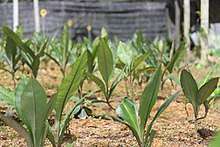Labisia pumila
| Labisia pumila | |
|---|---|
 | |
| Scientific classification | |
| Kingdom: | Plantae |
| Clade: | Angiosperms |
| Clade: | Eudicots |
| Clade: | Asterids |
| Order: | Ericales |
| Family: | Primulaceae |
| Genus: | Labisia |
| Species: | L. pumila |
| Binomial name | |
| Labisia pumila | |
Labisia pumila (kacip Fatimah, /ˈkɑːtʃɪpfɑːtɪmɑː/) is a flowering plant in the Primulaceae family native to Malaysia.[1] It is a small, woody and leafy plant with leaves of 20 cm (7.9 in) in length, and grows widely in the shade of the tropical forest floor. The plant is used in traditional medicine of the Malay community, in which it's believed to contain benefits relating to women's health.
Description
Labisia is a herbaceous plant that grows in low clusters, with solitary or rarely branching stems and fine, hairy roots. The leaves are oblong-shaped, hairy on its underside and can grow to 20–40 cm (7.9–15.7 in) in length. The inflorescence are brown and 5–6 cm (2.0–2.4 in) long.[2] The plant thrives under the shade, away from direct sunlight, and grows well in moist or loamy soil.[1] It propagates by its rhizomes, leaves and/or seeds, and when cultivated is harvested about a year after planting.[1] The plant is indigenous to Malaysia, but also found in Sumatera, Java and Borneo.[2] Three varieties of Labisia have been described: var. Alata, var. Lanceolata dan var Pumila.[3]
The popular name for the plant is kacip fatimah ("Fatimah's betel cutter"; compare to tongkat ali, i.e. Ali's walking stick). Other common names of the plant include "Selusoh Fatimah", "pokok pinggang", "rumput palis", "tadah matahari", "mata pelanduk rimba", "bunga belungkas hutan", "remoyan batu" and Sangkoh.[3]
Uses
In folk medicine L. pumila was thought to be useful for a number of applications, including labor induction and treating venereal disease and flatulence.[4] The plant has been researched for use in making cosmeceutical products.[4]
The plant's extract has been commercially formulated for consumption in capsule and tablet form,[3] as well as an ingredient in energy drinks.[5] In Malaysia, Labisia was highlighted in 2010 as one of five local herbs to developed commercially on a large scale via the Economic Transformation Programme.[6][7]
Chemical constituents
Despite its long history of traditional use, the active components and mode of action have not been well studied, though some preliminary research has been published.[8][9][10] It has been reported that Labisia contains two novel benzoquinoid compounds,[11] as well as gallic acid, caffeic acid, rutin, and myricetin.[9] One study claims that the leaves contain significantly higher level of saponins compared to its stems and roots.[9]
References
- 1 2 3 Wan Hassan, W.E. (2006). Healing herbs of Malaysia. Kuala Lumpur: Federal Land Development Authority (FELDA). p. 112.
- 1 2 Joseph Samy; M. Sugumaran; K.L.W. Lee (2005). K.M. Wong, ed. Labisia pumila, in Herbs of Malaysia. Times Edition. p. 135.
- 1 2 3 Noor'ain bt. Shamsuddin (2014-01-20). "Kacip Fatimah". MyHealth portal by the Malaysian Ministry of Health. Archived from the original on 2014-09-26. Retrieved 2014-09-26.
- 1 2 Chua LS, Lee SY, Abdullah N, Sarmidi MR (2012). "Review on Labisia pumila (Kacip Fatimah): bioactive phytochemicals and skin collagen synthesis promoting herb". Fitoterapia. 83 (8): 1322–35. doi:10.1016/j.fitote.2012.04.002. PMID 22521793.
- ↑ Azman, Sulhi (2017-08-02). "Power Root boosts stake in UAE unit". TheEdgeMarkets.com. Retrieved 2017-08-04.
- ↑ "EPP 1 High-Value Herbal Products". Performance Management and Delivery Unit (PEMANDU). Retrieved 2016-08-04.
- ↑ Prime Minister's Department, Malaysia (2017). Malaysia Productivity Blueprint: Driving Productivity of the Nation. Economic Planning Unit. pp. 4–32. ISBN 978-967-5842-10-8.
- ↑ Singh GD, Ganjoo M, Youssouf MS, Koul A, Sharma R, Singh S, Sangwan PL, Koul S, Ahamad DB, Johri RK (2009). "Sub-acute toxicity evaluation of an aqueous extract of Labisia pumila, a Malaysian herb". Food and Chemical Toxicology. 47 (10): 2661–2665. doi:10.1016/j.fct.2009.07.031. PMID 19654032.
- 1 2 3 Karimi E, Jaafar HZ, Ahmad S (2011). "Phytochemical analysis and antimicrobial activities of methanolic extracts of leaf, stem and root from different varieties of Labisa pumila Benth". Molecules. 16 (6): 4438–4450. doi:10.3390/molecules16064438. PMID 21623314.
- ↑ Ali Z, Khan IA (2011). "Alkyl phenols and saponins from the roots of Labisia pumila (Kacip Fatimah)". Phytochemistry. 72 (16): 2075–2080. doi:10.1016/j.phytochem.2011.06.014. PMID 21784496.
- ↑ Houghton, P.J.; J.A. Jamal; Milligan S. (1999). "Studies on Labisia pumila herb and its commercial products". J Pharma Pharmacol (51): 236.